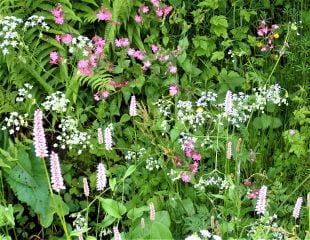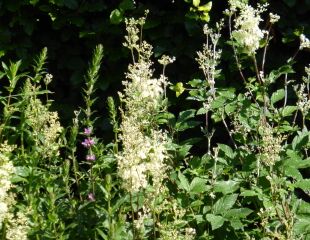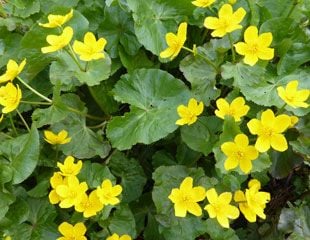How to Create a Wild garden
Setting aside part of your garden for "Wilding" or creating a wildlife garden gives another dimension to a garden. Over time, it will increase the wildlife visitors to your garden and the number and variety of wild flowers. In my garden there is a wild area which, over several years, has been left to go wild. The wildflowers have imported themselves, although you can give nature a hand.
Creating a wildlife area can be done slowly, just letting nature take over and see what comes naturally. Some gardeners prefer to introduce specific plants and wildflowers. In my own garden I have left an area to develop naturally, and it is amazing the range of wild flowers which appear, (as if from nowhere,) over the years. "Wilding" lets nature take its course, but you can be more creative and introduce perennial wildflowers, tips, and advice about both below.
Whichever route you take, the type of wild flowers which appear, or which you select will be suited to your garden environment. The old rule "Right Plant, Right Place" applies just the same. If the wild area of your garden is damp, or boggy, Marsh Marigolds make take up residence naturally, or you may plant them, whereas a Corn Poppy will not and would not not thrive if planted. Wildflowers, like any other plants, look for a garden which matches their natural growing environment.
You can also attract bees and butterflies to your garden with conventional planting- check out Wildlife friendly Plants and 6 pages of ideas of bee and butterfly friendly planting.
Video explaining how to create a wild area, what to expect and keeping the balance of nature.
What is "Wilding"
Wilding is letting nature take over, which I have done in parts of the garden, including the area shown above. Over time, many wild flowers have appeared. Below are images of some wildflowers which have established themselves. The wild part of my garden is a damp, boggy area next to a stream and also a shady area within some trees, so naturally the wildflower plants which have settled themselves are those suited this habitat.
All the dozen images are genuine, all from my garden, and none of these wildflowers were specially planted but arrived as I left the area to go wild. I hope this shows what to expect if you decide to let a section of your garden go wild. There are more wildflowers than the images portray.
To maintain a balance, I do some gardening, otherwise the more vigorous weeds would take over. This means checking areas of nettles and brambles to allow some to develop, but not to overtake the other flowers. It is important to maintain the balance and not let weeds take over; they are vigorous. It is sometimes said that a weed is a flower in the wrong place. Some are just weeds, images to help spot the most virulent of weeds.












Creating a wild flower garden
The garden illustrated above was created almost by chance; it is what nature provided. If you want to create a more specific look, you can add to the backdrop of wild flowers by planting additional perennial wildflowers of your choice. This also speeds up the process as it can take quite some time (as in a number of years) for wildflowers to establish themselves naturally.
You can do this in several ways.
The first is to introduce established plants, which I have done in a small way: planting Cirsium rivulare 'Atropurpureum' . Although not a native wildflower plant, it looks good in a wild setting and the bees go mad for it, so I added it in alongside the steam. This is also a perennial, and so graces the garden each year.
Alternatively, you can buy small plug plants or seeds and introduce these into the wild area. If you are doing this for the first year or so you will need to clear grasses and "weeds" from the immediate planting area to give the new plants a chance to get established.
Or you can just leave the area and keep an eye on what grows. Thin out unwanted visitors and keep the balance of weeds and flowers. If you feel that not enough of your wildflower favourites are seeding themselves naturally, give nature a hand and sow some perennial wildflowers. It is important to distinguish between annual and perennial wildflowers. The planting scheme, wilding, is based on mainly perennial flowers so that it is easily sustainable year after year.
Wilding is different from creating an annual wildflower patch or meadow. If this is your preferred route, you will need to clear the area and keep it weed free, which is very difficult in a wild garden area. Many of the wildflower meadows in the large show gardens we visit are an annual display. They are made from annual seeds which will die back each year. This method of creating a wildflower garden is the very colourful and eye-catching and it is also time consuming. It looks casual but is high maintenance.
Tips and growing instructions for creating a wild flower area.
Why Nettles are important

On the left is Caterpillars of a peacock butterfly on nettle leaves and on the right a Small Tortoiseshell butterfly sunning itself sitting on a stinging nettle.
We are mindful to plant for butterflies, but we need to think about caterpillars too, which is why we need nettles.

Nettles are wildlife-friendly and support over 40 species, including many butterflies. Their sting deters predators and their threat, which is mainly being eaten by grazing animals. This makes nettles a haven for insects, lava, and caterpillars.
Don't forget your lawn
For many years, a well manicured, velvet green weed free lawn has been a gardening goal. Fortunately, that is changing with the drive to greener gardening, the use of fewer pesticides and looking after wildlife.
If wilding in your garden seems to be too much, why not set aside part of your lawn to go its own way. Let it grow. You don't even have to plant in it, just leave it alone. Long grass is good for wildlife, providing shelter to beetles, frogs, various caterpillars of moths and butterflies, grasshoppers. The grass will flower producing pollen and wildflowers may seed into it. Clover has time to grow, and that's a big plus for the bees.
It's also very relaxing to look at.
paged updated 06.01.2024
